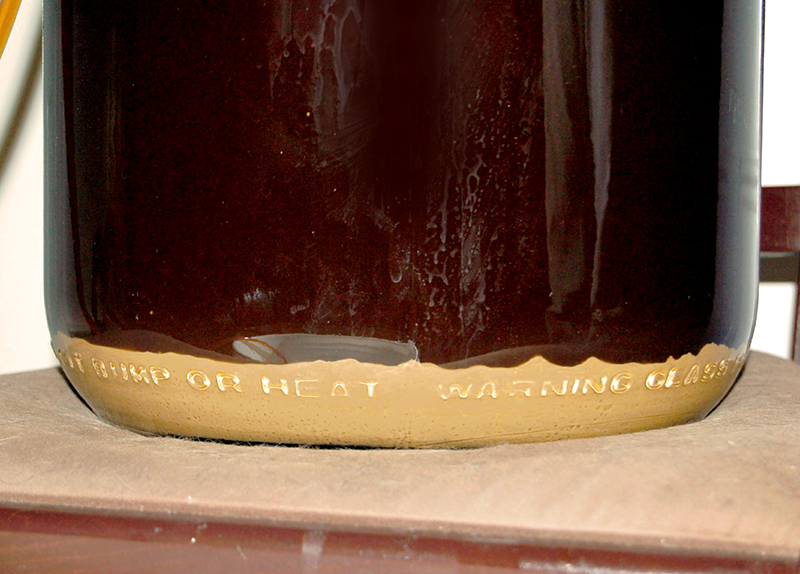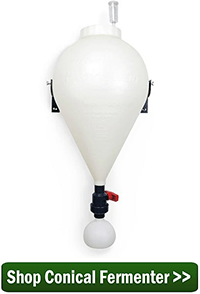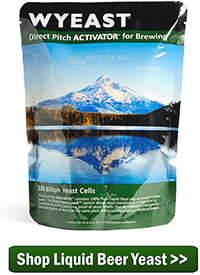 After bottling a batch of beer, many homebrewers have looked at that inch-deep layer of yeast and wondered, “Hey, isn’t there something I can do with all that yeast?” As a matter of fact, there is!
After bottling a batch of beer, many homebrewers have looked at that inch-deep layer of yeast and wondered, “Hey, isn’t there something I can do with all that yeast?” As a matter of fact, there is!
When we think about reusing yeast cake, our natural inclination is to pour another batch of wort right onto it and let ‘er rip. Why not save a few bucks, right? While it is possible to be successful with this strategy, there are a number of factors to consider when reusing yeast cake. Among others, these include:
- Is the style of homebrew appropriate for the yeast being used? If pitching wort onto an existing yeast cake, the styles of the two beers should be relatively similar. Many American and English ale yeasts can be used interchangeably to produce a variety of ales, so you could probably get away with using an ale yeast to make another ale. The same thing with many of the European lager strains. The main exception is with very distinctive yeast strains,
 especially those for Belgian ales and German hefeweizen. You’d be safe if reusing yeast cake from an English pale ale to ferment an American stout, but you obviously wouldn’t want to use a Belgian strain to ferment an English pale ale (though you may end up with a very tasty Belgian pale!).
especially those for Belgian ales and German hefeweizen. You’d be safe if reusing yeast cake from an English pale ale to ferment an American stout, but you obviously wouldn’t want to use a Belgian strain to ferment an English pale ale (though you may end up with a very tasty Belgian pale!).
- How long has the beer been sitting on the yeast cake to be reused? The longer the beer has been sitting on the yeast, the greater the number of yeast cells that may be mutated or dead. Dead and mutated yeast cells can contribute off-flavors to your beer, so if you plan on reusing yeast cake, use one that has only been in primary for a short amount of time (7-10 days).
- What was the gravity of the original beer? High gravity fermentations and the alcohol produced from them stress yeast more than lower gravity fermentations. And yeast stress leads to – you guessed it – off-flavors. You’d be better off pitching a high gravity wort onto the yeast cake from a low – to mid – gravity fermentation.
- How hoppy was the original beer?
 The amount of hops in the first beer can influence the second. You generally want to pitch a hoppier beer onto a yeast cake from a less hoppy beer (e.g. pitch an IPA onto the yeast cake of a pale ale), otherwise you may end up with excessive hop bitterness or flavor.
The amount of hops in the first beer can influence the second. You generally want to pitch a hoppier beer onto a yeast cake from a less hoppy beer (e.g. pitch an IPA onto the yeast cake of a pale ale), otherwise you may end up with excessive hop bitterness or flavor.
- What color are the two beers? As with hops and bitterness, the color of the first beer can influence the second one. To avoid a change in beer color, pitch a darker wort onto the yeast cake from a lighter beer. For example, pitch a stout onto the yeast cake of an amber ale.
Other issues that come into play when reusing yeast cake include accurately predicting the number of yeast cells being pitched and whether there was any infection in the original batch. For these reasons, it may be worth starting with a batch of fresh beer yeast. If you really want to reuse yeast cake, consider harvesting and washing the yeast to reduce the impact of dead yeast cells, beer color, and bitterness, and then use an online calculator to get an estimate of how much yeast slurry to pitch into the second beer. And as always when working with beer yeast, practice impeccable sanitation techniques to avoid contaminating the yeast.
infection in the original batch. For these reasons, it may be worth starting with a batch of fresh beer yeast. If you really want to reuse yeast cake, consider harvesting and washing the yeast to reduce the impact of dead yeast cells, beer color, and bitterness, and then use an online calculator to get an estimate of how much yeast slurry to pitch into the second beer. And as always when working with beer yeast, practice impeccable sanitation techniques to avoid contaminating the yeast.
Have you ever pitched onto an old yeast cake? How did it work out?
—–
David Ackley is a beer writer, brewer, and self-described “craft beer crusader.” He holds a General Certificate in Brewing from the Institute of Brewing and Distilling and is founder and editor of the Local Beer Blog.

I am still waiting for an answer to my one question which I asked twice: How many ounces of Flower hops equal three ounces of the pellet hops:
Thanks.
Anne, so sorry you had to ask 3 times. We did not get your question the first two times. Both leaf and pellets are the same by weight.
hi I clicked a link in my email, (I do subscribe to your newsletter), and here I am again lol. I think that the question that you just answered above could be one that I asked at one time but not sure. if it was me who asked this I had asked if the weight would be the same as using pellet hops. I didn’t think they would have the same moisture content so making them a different actual amount when you considered the amount of water in fresh hops. In any case I thank you for the info and will give it a try this year. I only asked as I discovered a large and unused crop of very nice citrus smelling hops growing next door to where I live and they go t waste every year so I was thinking of harvesting and drying them until winter as it is too warm in my apt to make beer in the summer time.
Hi Ed,
Brilliant blog!
I recently started a practice of bringing my old yeast cake to boil in my brew water for my next batch. (red wine, not beer). I read somewhere that yeasts will eat other yeasts, and dead, decomposed yeast cells make a good wine nutrient. I’ve experienced no problems, and the fermentation seems to go a little faster. I’ll be honest, I broke my hydrometer, so until I get another one, I won’t know if the dead yeast is working as a nutrient. I use Lavlin EC1118, so my potential ABV is around 18%, and I was getting in the 10-12% range without using any yeast nutrient (plenty of sugar). I’ll be interested to find out if boiling the dead yeast works as a nutrient to help achieve higher abv%. I don’t need 18%, but I personally don’t like the taste of reds until they hit at least 13%.
I hadn’t really thought about reusing the cake as a starter. $0.85 for a pack of yeast seems reasonable. Also, I’ve read that yeasts do evolve. I believe you wrote mutate, which is something different, and perhaps I’m not understanding, but the Lavlin 1118 strain is a good one. I don’t want it to evolve, or mutate, into something else.
I used to brew 15 years ago, just started back in the last few months, so my comments are mostly based on anecdotal evidence. Your expert insight is always welcome.
Thank you again